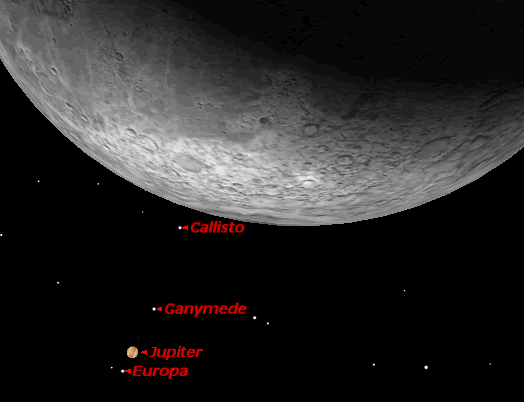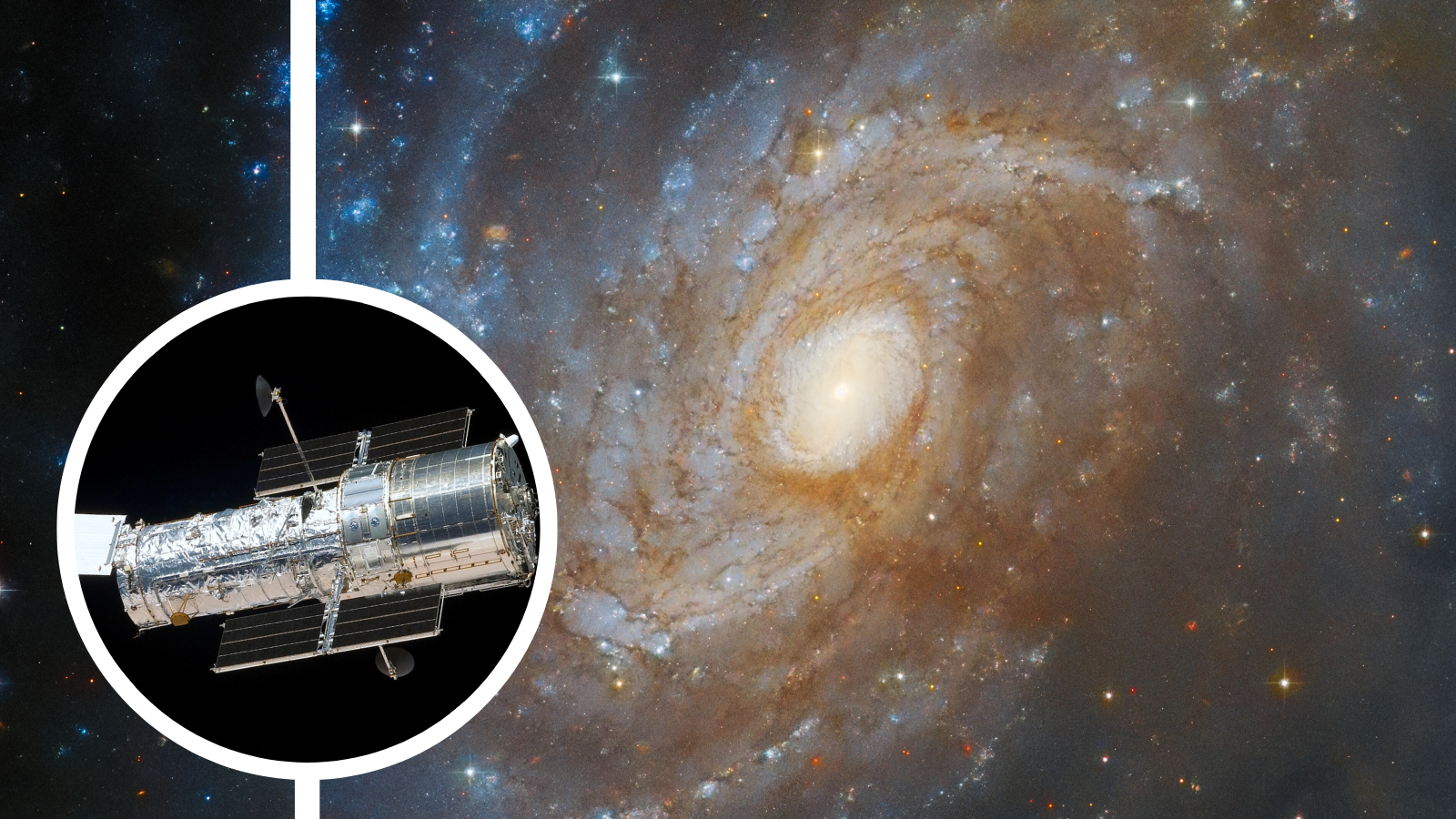
A rare and spectacular event will occur in the early morning hours of Tuesday, Dec. 7 when the brilliant planet Jupiter and three of its largest satellites pass behind Earth's Moon.
Astronomers refer to this phenomenon as an "occultation," taken from the Latin occultare, which means "to conceal." This eye-catching sight will be visible in complete darkness across all of eastern and much of central North America.
The waning Moon will be 26 percent illuminated, a crescent just 4-? days before new.
It's been decades since Jupiter has played hide-and-seek for U.S. skywatchers under favorable dark-sky circumstances. Across the western and central states, Jupiter was occulted at dawn on Oct. 19, 1968 in a widely watched event. For viewers farther East the wait has been considerably longer.
The last time New Yorkers were treated to such a favorably placed dark-sky Jupiter occultation was on Sept. 3, 1889. After 2004, there will not be another similarly favorable Jupiter occultation for most North Americans until Oct. 6, 2026.
Where it's visible
Earth's Moon and Jupiter are of course very far apart, but they both travel in roughly the same plane of space, making an occultation possible when the geometry is just right. What you will see (or not see) depends on location.
Get the Space.com Newsletter
Breaking space news, the latest updates on rocket launches, skywatching events and more!
Along the Eastern Seaboard, the Moon will be more than 20 degrees above the horizon when it covers Jupiter in the predawn hours. (Your clinched fist, held at arm's length, measures approximately 10 degrees in width.) The Moon will have risen to more than 30 degrees above the east-southeast horizon by the time Jupiter begins to reappear.
The Moon's altitude will gradually diminish for viewing locations farther West.
Across the western Great Lakes, the eastern Great Plains and down into the Deep South for example, the emergence of Jupiter occurs with the Moon about 20 degrees high. Along a line from about central North Dakota down into western Texas, Jupiter's disappearance will roughly coincide with moonrise, but when Jupiter is ready to emerge, the Moon will have climbed up to an altitude of about 10 degrees.
West of this line, viewers will only be able to see Jupiter's reappearance, with the Moon quite low. Along a line running from just west of Edmonton, Alberta, south through northern Idaho, down to Nogales, Arizona, Jupiter's emergence occurs at moonrise. To the west of this line, no occultation will occur.
Out of the 48 contiguous United States, only Washington, Oregon and California are completely shut out of this sky show, as the main event will have already taken place before the Moon and Jupiter rise. But even from these localities, the sight of Jupiter hovering just above and to the right of the lunar crescent as they rise into full view will still make for a very striking sight.
Texas grazing
A most interesting sight will be seen from a 37-mile-wide strip centered from roughly Marfa to Matagorda in Texas, then continuing east across the Gulf of Mexico to Key West, Florida. Within this zone the Moon's mountainous edge will be silhouetted against Jupiter for several minutes, but the planet will never be completely covered.
The graze will take place near the crescent's southern cusp.

The best views will be seen at the northern edge of the graze zone, where the partial occultation will last the longest -- about 20 minutes. San Antonio, Texas is very close to the northern edge; in the Florida Keys, the town of Marathon is also situated very near to the graze zone's northern limit.
To the south of the graze zone, the Moon will miss Jupiter, skimming just barely above it.
When to watch
The amount of time that Jupiter will be completely hidden behind the Moon depends on your location and can range from as little as a few minutes to just over an hour. This table shows when Jupiter will disappear and reappear from select cities on Dec. 7, rounded off to the nearest minute. The times are based on predictions by the International Occultation Timers Association (IOTA). More detailed information, including maps of the occultation zone and times for more than 275 cities in North America, is available at the IOTA website.
| Time Zone | Disappear | Altitude | Reappear | Altitude | |
Atlanta | EST | 3:55 a.m. | 16? | 4:53 a.m. | 27? |
Austin | CST | 3:04 a.m. | 7? | 3:28 a.m. | 12? |
Boston | EST | 3:59 a.m. | 23? | 5:08 a.m. | 33? |
Chicago | CST | 2:50 a.m. | 10? | 3:54 a.m. | 21? |
Denver | MST | n/a* | ---* | 2:43 a.m. | 8? |
Halifax | AST | 5:10 a.m. | 28? | 6:10 a.m. | 35? |
Helena | MST | n/a* | ---* | 2:47 a.m. | 2? |
Kansas City | CST | 2:49 a.m. | 5? | 3:48 a.m. | 16? |
Miami | EST | 4:15 a.m. | 26? | 4:46 a.m. | 32? |
Montreal | EST | 4:00 a.m. | 20? | 5:03 a.m. | 29? |
New Orleans | CST | 3:03 a.m. | 14? | 3:38 a.m. | 21? |
New York | EST | 3:56 a.m. | 21? | 5:06 a.m. | 32? |
Washington | EST | 3:55 a.m. | 19? | 5:03 a.m. | 31? |
Winnipeg | CST | 2:53 a.m. | 2? | 3:51 a.m. | 11? |
What to look for
| Ancient Occultation Is Jupiter a Clue to The Fabled Christmas Star? Michael Molnar, an astronomer and former manager of the Physics Instructional Labs at Rutgers University, believes that the planet Jupiter also holds the key to resolving one of the world's great mysteries: What might have been the fabled Star of Bethlehem?
In his book, "The Star of Bethlehem, The Legacy of the Magi" (Rutgers University Press, 1999), Molnar says that an ancient Roman coin, minted in the historic city of Antioch holds the answer. Molnar became intrigued by the image of a ram looking back at a star. After doing considerable research using astronomical, astrological and historical clues, he argues that the image of the star on the coin was Jupiter, while the ram looking back at the star was the zodiacal constellation of Aries, a star pattern that was also the symbol of Judea. "In Roman times," he adds, "astrologers claimed that the Moon enhanced the astrological influences of a planet during close conjunctions." Ancient astrologers, such as the Magi, very likely believed that a new king would be born when the Moon passed in front of Jupiter - an eclipse that would herald the birth of Christ. And modern-day computer wizardry enabled Molnar to discover that while Jupiter was in Aries, it was occulted by a crescent Moon on April 17, 6 B.C. Molnar believes that the Star of Bethlehem was not a singular occurrence, but was actually composed of an entire sequence of events, which also included Jupiter's appearance in the eastern sky within the sign of Aries. But the 6 B.C. occultation of Jupiter on April 17 was perhaps the most important component. He adds: "Writing during the reign of Emperor Constantine, Firmicus Maternus, a christianized pagan, claimed that these conditions in Aries gave rise to immortal and divine people! I believe that he was making a reference to the Star of Bethlehem." But the upcoming Jupiter occultation differs from the one in 6 B.C. in that it will not occur in Aries, but within the constellation Virgo. | Ancient Occultation | Is Jupiter a Clue to The Fabled Christmas Star? Michael Molnar, an astronomer and former manager of the Physics Instructional Labs at Rutgers University, believes that the planet Jupiter also holds the key to resolving one of the world's great mysteries: What might have been the fabled Star of Bethlehem?
In his book, "The Star of Bethlehem, The Legacy of the Magi" (Rutgers University Press, 1999), Molnar says that an ancient Roman coin, minted in the historic city of Antioch holds the answer. Molnar became intrigued by the image of a ram looking back at a star. After doing considerable research using astronomical, astrological and historical clues, he argues that the image of the star on the coin was Jupiter, while the ram looking back at the star was the zodiacal constellation of Aries, a star pattern that was also the symbol of Judea. "In Roman times," he adds, "astrologers claimed that the Moon enhanced the astrological influences of a planet during close conjunctions." Ancient astrologers, such as the Magi, very likely believed that a new king would be born when the Moon passed in front of Jupiter - an eclipse that would herald the birth of Christ. And modern-day computer wizardry enabled Molnar to discover that while Jupiter was in Aries, it was occulted by a crescent Moon on April 17, 6 B.C. Molnar believes that the Star of Bethlehem was not a singular occurrence, but was actually composed of an entire sequence of events, which also included Jupiter's appearance in the eastern sky within the sign of Aries. But the 6 B.C. occultation of Jupiter on April 17 was perhaps the most important component. He adds: "Writing during the reign of Emperor Constantine, Firmicus Maternus, a christianized pagan, claimed that these conditions in Aries gave rise to immortal and divine people! I believe that he was making a reference to the Star of Bethlehem." But the upcoming Jupiter occultation differs from the one in 6 B.C. in that it will not occur in Aries, but within the constellation Virgo. |
| Ancient Occultation | ||
Is Jupiter a Clue to The Fabled Christmas Star? Michael Molnar, an astronomer and former manager of the Physics Instructional Labs at Rutgers University, believes that the planet Jupiter also holds the key to resolving one of the world's great mysteries: What might have been the fabled Star of Bethlehem?
In his book, "The Star of Bethlehem, The Legacy of the Magi" (Rutgers University Press, 1999), Molnar says that an ancient Roman coin, minted in the historic city of Antioch holds the answer. Molnar became intrigued by the image of a ram looking back at a star. After doing considerable research using astronomical, astrological and historical clues, he argues that the image of the star on the coin was Jupiter, while the ram looking back at the star was the zodiacal constellation of Aries, a star pattern that was also the symbol of Judea. "In Roman times," he adds, "astrologers claimed that the Moon enhanced the astrological influences of a planet during close conjunctions." Ancient astrologers, such as the Magi, very likely believed that a new king would be born when the Moon passed in front of Jupiter - an eclipse that would herald the birth of Christ. And modern-day computer wizardry enabled Molnar to discover that while Jupiter was in Aries, it was occulted by a crescent Moon on April 17, 6 B.C. Molnar believes that the Star of Bethlehem was not a singular occurrence, but was actually composed of an entire sequence of events, which also included Jupiter's appearance in the eastern sky within the sign of Aries. But the 6 B.C. occultation of Jupiter on April 17 was perhaps the most important component. He adds: "Writing during the reign of Emperor Constantine, Firmicus Maternus, a christianized pagan, claimed that these conditions in Aries gave rise to immortal and divine people! I believe that he was making a reference to the Star of Bethlehem." But the upcoming Jupiter occultation differs from the one in 6 B.C. in that it will not occur in Aries, but within the constellation Virgo. |
Jupiter is bright, shining at magnitude minus 1.8. That's brighter than any star in the sky on an astronomers' scale in which negative numbers denote the brightest objects.
You might be able to see Jupiter disappear using no optical aid at all, but binoculars or a small telescope will certainly give a much better view. The reappearance of the planet should be plainly visible to the unaided eye.
With the naked eye, Jupiter appears as a star-like point of light. But with telescopes and even binoculars it becomes a discernable disk. Observed with magnification, it will not disappear or reappear in an instant as a star would, but rather it will take an interval of time to fully occult and emerge
For most locations, it will take the Moon at least a minute to completely cover or uncover Jupiter. In south-central Texas and south Florida, just to the north of the partial occultation zone, this process could take up to three minutes or more.
The most spectacular part of this sky show will be the gradual reappearance of Jupiter from behind the Moon's dark limb.
The description of Jupiter's gradual reappearance from behind the Moon's dark limb in 1968 was described as "quite dramatic" as seen from Chicago. Meanwhile an observer at La Pryor, Texas noted that the most spectacular feature for him was the naked-eye impression of Jupiter looking "like a brightening jewel on the dark limb of the Moon."
Also likely to be visible on this morning will be earthshine, a faint grayish-blue illumination of the dark part of the Moon's disk.
This dim light is produced by sunlight striking the "dark" side of the Moon after first being reflected from the Earth's surface, clouds and atmosphere. The effect will give the Moon an almost 3-D quality and will enhance the overall spectacle.
Bonus: The Galilean moons
During the occultation, it will be possible to also watch three of Jupiter's four largest satellites disappear.
The moons will likely be lost in the glare of the bright lunar crescent just before they disappear behind the Moon, but their emergence from behind the Moon's dark side should be readily visible through binoculars or a small telescope.
Callisto will emerge from behind the Moon's dark limb about 13 or 14 minutes before Jupiter itself, followed by Ganymede about 9 or 10 minutes later. Then, just about one or two minutes after Jupiter has fully reappeared, Europa will come into view.
Due to the angular sizes of the three Jovian moons, they will take up to a few seconds to brighten as they move out from behind the Moon. The fourth Galilean satellite, Io, will be behind Jupiter and not part of the show.
Basic Sky Guides
- Telescope Buying Tips
- Sky Calendar & Moon Phases
- 10 Steps to Rewarding Stargazing
- Understanding the Ecliptic and the Zodiac
- False Dawn: All about the Zodiacal Light
- Reading Weather in the Sun, Moon and Stars
- How and Why the Night Sky Changes with the Seasons
- Night Sky Main Page: More Skywatching News & Features

Starry Night software brings the universe to your desktop. Map the sky from your location, or just sit back and let the cosmos come to you.

| DEFINITIONS |
Degrees measure apparent sizes of objects or distances in the sky, as seen from our vantage point. The Moon is one-half degree in width. The width of your fist held at arm's length is about 10 degrees. Magnitude is the standard by which astronomers measure the apparent brightness of objects that appear in the sky. The lower the number, the brighter the object. The brightest stars in the sky are categorized as zero or first magnitude. Negative magnitudes are reserved for the most brilliant objects: the brightest star is Sirius (-1.4); the full Moon is -12.7; the Sun is -26.7. The faintest stars visible under dark skies are around +6. |
Join our Space Forums to keep talking space on the latest missions, night sky and more! And if you have a news tip, correction or comment, let us know at: community@space.com.

Joe Rao is Space.com's skywatching columnist, as well as a veteran meteorologist and eclipse chaser who also serves as an instructor and guest lecturer at New York's Hayden Planetarium. He writes about astronomy for Natural History magazine, Sky & Telescope and other publications. Joe is an 8-time Emmy-nominated meteorologist who served the Putnam Valley region of New York for over 21 years. You can find him on Twitter and YouTube tracking lunar and solar eclipses, meteor showers and more. To find out Joe's latest project, visit him on Twitter.









